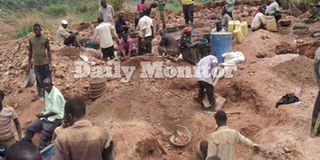Prime
Mubende illegal gold miners apply for location licence

Gold miners at Lujinji mining site in Mubende District. The miners want a location licence so as to legalise their activities. FILE PHOTO
What you need to know:
Resistant. The miners have repeatedly resisted attempts to evict them.
Mubende. For about five years now, illegal gold miners from various parts of Uganda have occupied two hills of about 44 acres in Kitumbi Sub-county, Mubende District.
Estimates indicate the number of the miners – known as artisanal miners - could be as high as 10,000 in Lujinji A and B villages, in Kitumbi Sub-county alone.
Daily Monitor has learnt that in order to legalise their mining activities, the miners have applied for a location licence as prescribed in the Mining Act, 2003.
Mr Emmanuel Kibirige, the general secretary Ssingo Artisanal Gold Miners Association (SIGMA), has applied for the licence on behalf of the association.
“We applied for a location licence on the land where most of our members operate. This will allow us to operate legally and avoid encroaching on other people’s licensed areas,” he says.
Spread across the hill like a refugee camp, illegal miners in Kitumbi have been operating in an area licensed to a gold mining company called AUC Mining.
In 2012, AUC Mining secured an exploration licence from the Directorate of Geological Survey and Mines (DGSM) in the Ministry of Energy to explore gold in an area of about 207.3747 square kilometres of land in Kitumbi Sub-county.
Their licence expired on February 26, which by law requires them to relinquish at least 50 per cent of the land as they apply for a renewal.
According to Mr Kibirige, SIGMA has taken advantage of that provision to apply for a location licence.
A location licence, according to The Mining Act, 2003 section 54 (2), is a licence for prospecting and mining operations by methods which do not involve substantial expenditure and the use of specialised technology.
This is mostly meant for small-scale miners who do not have the capacity to afford high-tech equipment for mining.
“If we secure a licence, we will be able to engage in better and safer mining activities. We have been unable to invest money in improving standards and mining activities because we were unsure about the future,” Mr Kibirige said.
An illegal gold miner cannot walk into a bank and secure loan, whereas if they had a licence they could secure financing for mine improvement and standards.
“The licence also guarantees the security of tenure,” he added.
AUC Mining, which held the exploration licence, claims it has been unable to carry out any exploration activity on the land because of the influx of illegal miners.
There have been several attempts to evict illegal miners but this has been met with stiff opposition.
AUC Mining could not be reached for a comment but according to DGSM, they have applied for a renewal of the exploration licence.
According to the mining cadastre, a map showing the status of licensing in Uganda, Mubende has two mining leases – for the large-scale miners - and five location licences given to small-scale miners.
The current Mining Act does not recognise artisanal mining as a legal means of mining. However, there are amendments to the Mining Act being made to recognise artisanal mining since there are over 200,000 people participating in it countrywide.
According to Mr Don Binyina, the executive director African Centre for Energy and Mineral Policy, if the miners are granted a location licence, they will be required to follow several procedures.
“Artisanal miners currently do not pay royalties to the government and local government. If they get the licence, they will be required to pay royalties and annual rent to the government,” he Binyina said.
The Mining Act provides for the government to earn 80 per cent of royalties, the local government gets 17 per cent and the lawful occupiers of the land get 3 per cent.
However, even with artisanal miners selling one gramme of gold at Shs120,000, there are no records of any payment of royalties.
The industry
Mining currently contributes only 0.5 per cent to Gross Domestic Product.
However, these are statistics for the formal sector.
Informally, the contribution is about 3.5 per cent. There are also about 200,000 miners around the country, most of them unregulated.




